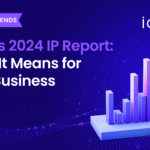
In collaboration with PatentRenewal.com, a company specializing in automated and transparent IP renewals, we explored the role of patents in collaborative research and development. PatentRenewal.com simplifies the IP renewal process for companies worldwide, offering cost-effective solutions that ensure seamless IP management.
This blog brings together our shared expertise to examine the challenges of collaborative R&D and their impact on the patent landscape.
Innovation thrives on collaboration. In today’s interconnected world, companies, universities, and research institutions frequently join forces to drive technological advancements. One critical element that underpins the success of collaborative research and development is patents. Patents protect intellectual property and also shape the partnership dynamic, providing fair value and commercial viability for collaborative innovations.
Why patents matter in collaborative R&D
Collaboration often brings together diverse expertise, funding, and resources, making it a powerful driver of innovation. However, without a clear framework for intellectual property management, the very success of these partnerships can lead to conflicts.
Here’s how patents support and streamline collaborative R&D:
1. Defining ownership and rights
Patents help establish clear ownership of innovations, preventing disputes among collaborators. In joint research projects, defining background, foreground, and post ground IP is crucial:
- Background IP: Pre-existing knowledge or patents brought into the collaboration.
- Foreground IP: New inventions arising directly from the partnership.
- Postground IP: Innovations developed after the project but building on its results.
A well-structured agreement ensures that all parties understand their rights, preventing conflicts and allowing for the smooth commercialization of new technologies.
2. Encouraging open knowledge sharing
While patents provide exclusivity, they also promote transparency by requiring detailed public disclosure of inventions. This helps research partners exchange knowledge confidently, knowing that their contributions are legally protected. Such openness accelerates the pace of innovation while maintaining legal safeguards for all parties involved.
3. Facilitating technology transfer and commercialization
Patents enable the transfer of technology from research institutions to industry, ensuring that groundbreaking discoveries reach the market. Universities, for example, often patent their innovations before licensing them to businesses for commercialization. This process bridges the gap between theoretical research and practical applications, fostering a cycle of continuous innovation.
Challenges and recent developments
Despite their advantages, patents in collaborative R&D require careful navigation. Recent insights shed light on key considerations and trends shaping the landscape in 2025 and beyond.
1. Managing patent ownership in international partnerships
Global R&D collaborations are on the rise, but differences in patent laws across jurisdictions create complexities. Recent research highlights that U.S.-China collaborations have a distinct impact on patent quality, benefiting Chinese patents more than U.S. ones. While Chinese patents see quality improvements through international partnerships, U.S. patents tend to experience a decline in quality when collaborating with China. Additionally, U.S. government-funded research has, in some cases, resulted in patents awarded to China-based entities, raising concerns about IP sovereignty and regulatory alignment.
2. The impact of emerging technologies on patentability
Innovations in AI, biotechnology, and quantum computing introduce new patent challenges, especially in collaborative R&D where multiple entities contribute to a single invention. AI-assisted innovations, for instance, raise legal questions about inventorship and ownership, as current laws in the U.S. and EU remain unclear on whether AI-generated inventions are patentable. Beyond AI, biotech and quantum patents often involve overlapping contributions, complicating ownership rights and licensing in partnerships. Given rapid innovation cycles, patents alone may not suffice—companies must balance trade secrets and copyrights to protect shared IP while ensuring fair attribution.
3. Patent maintenance in collaborative R&D
Patent fees and renewals can be a financial burden, especially for startups and research institutions. In many cases, collaborators must decide whether to jointly maintain patents or transfer ownership to a more financially stable entity. Strategic patent maintenance is critical to ensuring that valuable IP remains protected while minimizing unnecessary costs. Platforms like PatentRenewal.com help companies efficiently manage their patent portfolios while reducing hidden costs and administrative burdens.
Strategies for businesses to maximize patent value
To make the most of patents in joint research initiatives, businesses and research institutions should adopt proactive strategies:
- Implement clear IP agreements: Establish patent ownership, licensing terms, and revenue-sharing models at the outset of any collaboration.
- Use patent monitoring tools: Staying updated on competitors’ patents, expirations, and industry trends can provide a competitive edge.
- Prepare for post-patent scenarios: When key patents expire, industries often see waves of innovation. Companies should anticipate these shifts and position themselves to capitalize on expired patents for new product development.
Conclusion
Patents are indispensable in collaborative R&D, ensuring that innovation is both protected and shared in a structured manner. As global partnerships and emerging technologies reshape the innovation landscape, businesses must stay agile, informed, and strategic in their patent management approaches. By leveraging patent intelligence tools and adopting strong IP policies, organizations can turn patents into powerful assets for long-term success in collaborative research.
Search
Categories
- Announcement 6
- Case Study 1
- Expert Insights 7
- IamIP News 4
- Industry Trends 27
- Innovation Index 4
- New Release 9
- Platform News 2
- Press Release 1
- Webinar 13









